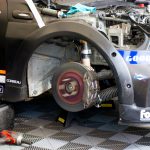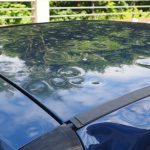Car enthusiasts know the pride that comes with a sleek, well-maintained vehicle. One crucial aspect of car maintenance often overlooked is protecting the paint from damage. Stone chips and road debris pose significant threats to the exterior of a car, leading to unsightly scratches, chips, and ultimately, paint damage. In this article, we’ll explore the impact of stone chips on car paint and provide valuable recommendations for shielding against this common hazard.
Understanding Stone Chips
Stone chips are tiny, often unnoticeable fragments of rocks or debris kicked up by passing vehicles. While seemingly insignificant, these tiny projectiles can wreak havoc on a car’s paintwork. The force of impact can leave behind visible marks, ranging from minor scratches to deep chips, exposing the underlying metal surface to potential rust and corrosion.
Consequences of Paint Damage
The consequences of neglecting paint protection go beyond mere aesthetics. Scratches and chips not only detract from the overall appearance of the vehicle but also compromise its structural integrity. Exposed metal surfaces are vulnerable to rust formation, leading to costly repairs down the line. Additionally, diminished resale value is another repercussion of neglected paintwork.
Protective Measures
Thankfully, there are several effective methods for shielding against stone chips and preserving the pristine finish of your car. From applying protective films to regular waxing and installing mud flaps, proactive measures can significantly reduce the risk of paint damage.
Applying Protective Films
One popular method for protecting car paint is the application of protective films. These transparent coatings create a barrier between the paint surface and external elements, absorbing the impact of stone chips and preventing them from causing damage. The application process involves meticulous cleaning and precise installation to ensure seamless coverage.
Regular Waxing

Waxing is another time-tested technique for maintaining the luster of car paint. By applying a layer of wax regularly, you create a protective shield that repels dirt, debris, and moisture, reducing the risk of scratches and chips. Incorporating waxing into your car care routine not only enhances the aesthetic appeal but also prolongs the lifespan of the paintwork.
Installing Mud Flaps
For drivers frequently traversing gravel roads or construction sites, installing mud flaps can provide an added layer of protection against road debris. These accessories are designed to deflect stones and other debris kicked up by the tires, minimizing the risk of paint damage to the lower panels of the vehicle. Installation is relatively straightforward and can be performed with basic tools.
Other Tips for Protection
In addition to the aforementioned methods, there are several other strategies for safeguarding car paint. Parking in shaded areas whenever possible can shield the vehicle from direct sunlight and reduce the risk of paint fading. Regularly cleaning the exterior with a gentle car wash solution and microfiber towels helps remove abrasive contaminants, maintaining the integrity of the paint finish.
Choosing the Right Protection
When selecting a paint protection method, it’s essential to consider factors such as durability, cost, and compatibility with your vehicle’s finish. While DIY options offer affordability and convenience, professional services often provide superior results and long-term peace of mind. Ultimately, the choice depends on individual preferences and budget constraints.
DIY vs. Professional Protection
Both DIY and professional paint protection options have their pros and cons. DIY solutions are cost-effective and can be applied at home, but may not offer the same level of durability and expertise as professional treatments. On the other hand, professional services ensure meticulous application and use high-quality materials, albeit at a higher cost.
Cost Considerations
The cost of paint protection varies depending on the method chosen and the size of the vehicle. DIY options such as waxing and applying protective films are relatively affordable, requiring minimal investment in materials and tools. Professional services, including ceramic coatings and paint sealants, come at a higher price but offer superior durability and long-lasting protection.
Conclusion
In conclusion, shielding against stone chips is essential for preserving the appearance and value of your car. By understanding the impact of road debris on paintwork and implementing proactive measures such as protective films, regular waxing, and mud flap installation, you can safeguard your vehicle against unsightly damage. Whether opting for DIY solutions or professional services, investing in paint protection is a worthwhile endeavor that pays dividends in the long run.
FAQs:
How common are stone chips on car paint?
Stone chips are prevalent, especially for vehicles frequently driven on highways or gravel roads. The risk increases during construction or road repair activities.
Can I repair stone chips myself?
Minor stone chips can be repaired using touch-up paint or DIY repair kits. However, deep or extensive damage may require professional intervention.
Are protective films visible on the car’s surface?
Modern protective films are virtually invisible when properly applied, preserving the aesthetics of the paintwork while providing reliable protection.
How often should I wax my car for optimal protection?
It’s recommended to wax your car every three to four months to maintain a durable protective layer and enhance the shine of the paint.
Will installing mud flaps affect the vehicle’s aerodynamics?
While mud flaps may slightly alter aerodynamics, the impact is minimal and outweighed by the benefits of protecting the car’s paint from road debris.
Last Updated on March 18, 2024 by admin

Mac is an Automotive enthusiast. He owns up to 15 vehicles. He deals with Auto problems and shows his skill to Car owners who are seeking any type of Car help.





